Whooping Cough: Comprehensive Analysis of Disease and Management
VerifiedAdded on 2023/01/17
|13
|800
|62
Report
AI Summary
This report provides a comprehensive overview of whooping cough, a highly contagious respiratory tract infection caused by Bordetella pertussis. It details the characteristics of the disease, including the severe hacking cough with a characteristic high-pitched intake of breath. The report examines the causative agent's features, including its Gram-negative nature, aerobic properties, and growth requirements. It also explores the reservoirs and modes of transmission, primarily through direct contact and droplet contact. Furthermore, the report outlines the symptoms, complications, and management strategies, including vaccination and antibiotic treatment. Finally, the report highlights methods of breaking transmission and the relevance of the research to areas like acupuncture and immune system improvement, with references to relevant research articles.
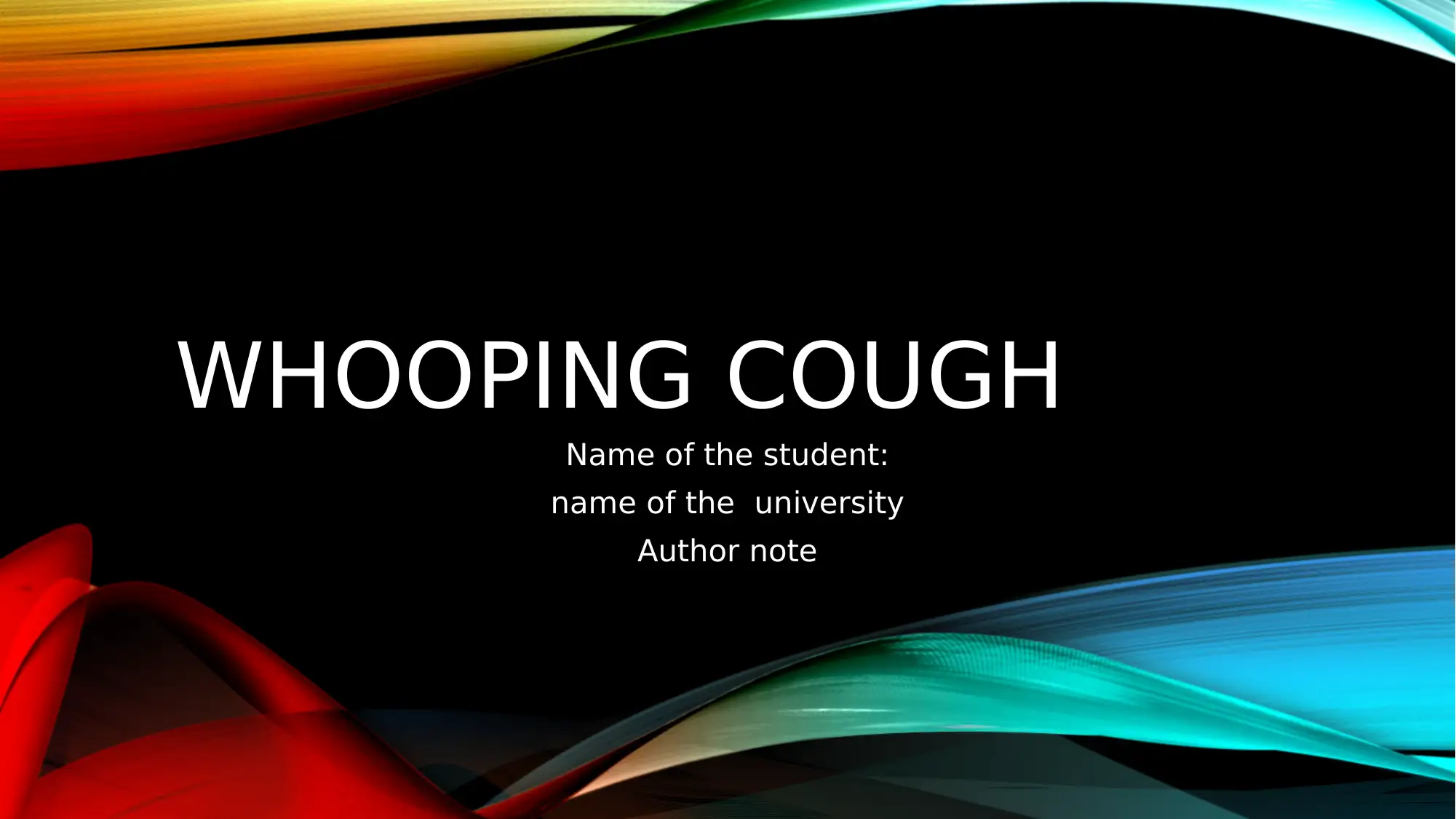
WHOOPING COUGH
Name of the student:
name of the university
Author note
Name of the student:
name of the university
Author note
Paraphrase This Document
Need a fresh take? Get an instant paraphrase of this document with our AI Paraphraser
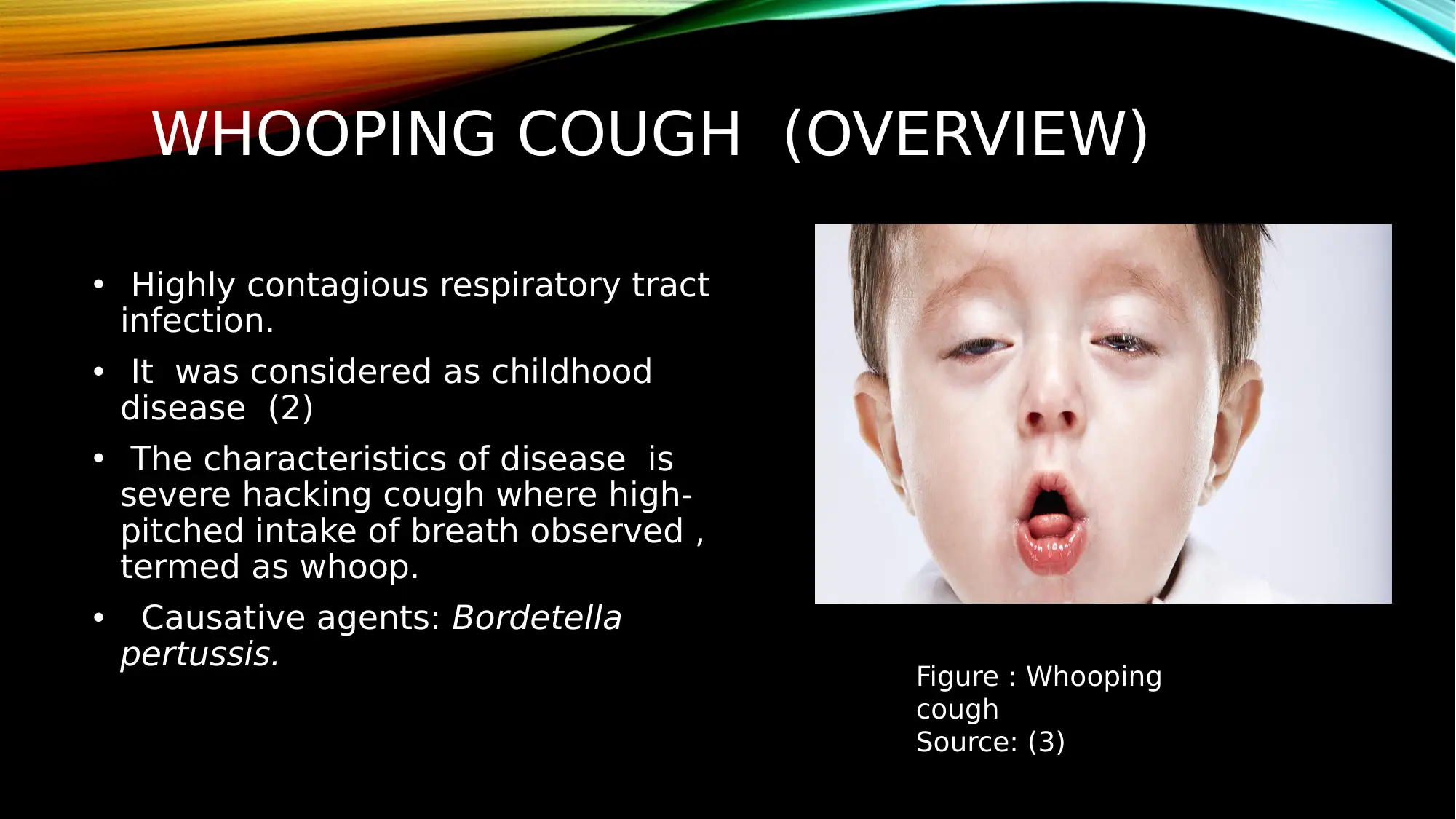
WHOOPING COUGH (OVERVIEW)
• Highly contagious respiratory tract
infection.
• It was considered as childhood
disease (2)
• The characteristics of disease is
severe hacking cough where high-
pitched intake of breath observed ,
termed as whoop.
• Causative agents: Bordetella
pertussis. Figure : Whooping
cough
Source: (3)
• Highly contagious respiratory tract
infection.
• It was considered as childhood
disease (2)
• The characteristics of disease is
severe hacking cough where high-
pitched intake of breath observed ,
termed as whoop.
• Causative agents: Bordetella
pertussis. Figure : Whooping
cough
Source: (3)
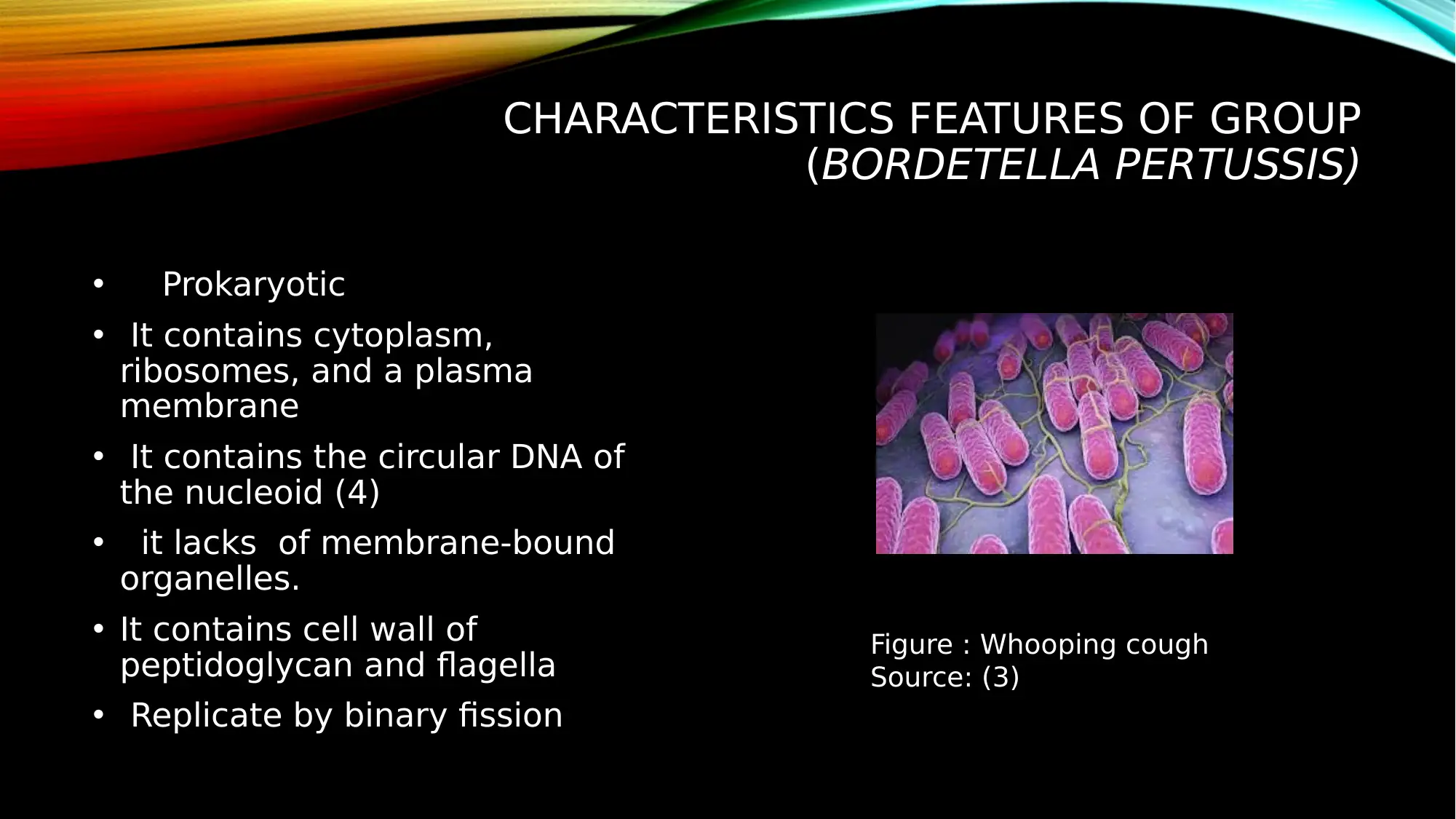
CHARACTERISTICS FEATURES OF GROUP
(BORDETELLA PERTUSSIS)
• Prokaryotic
• It contains cytoplasm,
ribosomes, and a plasma
membrane
• It contains the circular DNA of
the nucleoid (4)
• it lacks of membrane-bound
organelles.
• It contains cell wall of
peptidoglycan and flagella
• Replicate by binary fission
Figure : Whooping cough
Source: (3)
(BORDETELLA PERTUSSIS)
• Prokaryotic
• It contains cytoplasm,
ribosomes, and a plasma
membrane
• It contains the circular DNA of
the nucleoid (4)
• it lacks of membrane-bound
organelles.
• It contains cell wall of
peptidoglycan and flagella
• Replicate by binary fission
Figure : Whooping cough
Source: (3)
⊘ This is a preview!⊘
Do you want full access?
Subscribe today to unlock all pages.

Trusted by 1+ million students worldwide
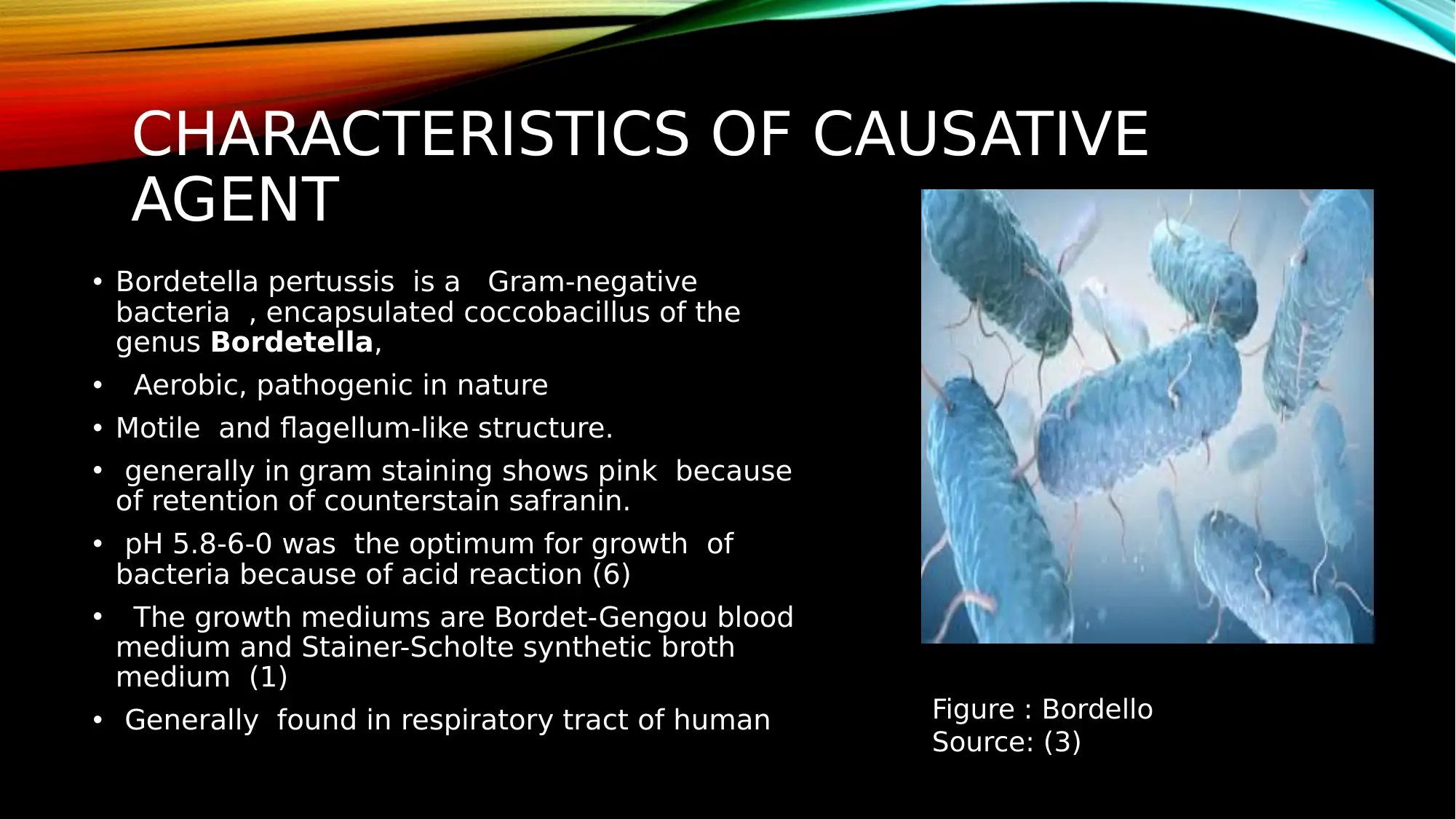
CHARACTERISTICS OF CAUSATIVE
AGENT
• Bordetella pertussis is a Gram-negative
bacteria , encapsulated coccobacillus of the
genus Bordetella,
• Aerobic, pathogenic in nature
• Motile and flagellum-like structure.
• generally in gram staining shows pink because
of retention of counterstain safranin.
• pH 5.8-6-0 was the optimum for growth of
bacteria because of acid reaction (6)
• The growth mediums are Bordet-Gengou blood
medium and Stainer-Scholte synthetic broth
medium (1)
• Generally found in respiratory tract of human Figure : Bordello
Source: (3)
AGENT
• Bordetella pertussis is a Gram-negative
bacteria , encapsulated coccobacillus of the
genus Bordetella,
• Aerobic, pathogenic in nature
• Motile and flagellum-like structure.
• generally in gram staining shows pink because
of retention of counterstain safranin.
• pH 5.8-6-0 was the optimum for growth of
bacteria because of acid reaction (6)
• The growth mediums are Bordet-Gengou blood
medium and Stainer-Scholte synthetic broth
medium (1)
• Generally found in respiratory tract of human Figure : Bordello
Source: (3)
Paraphrase This Document
Need a fresh take? Get an instant paraphrase of this document with our AI Paraphraser
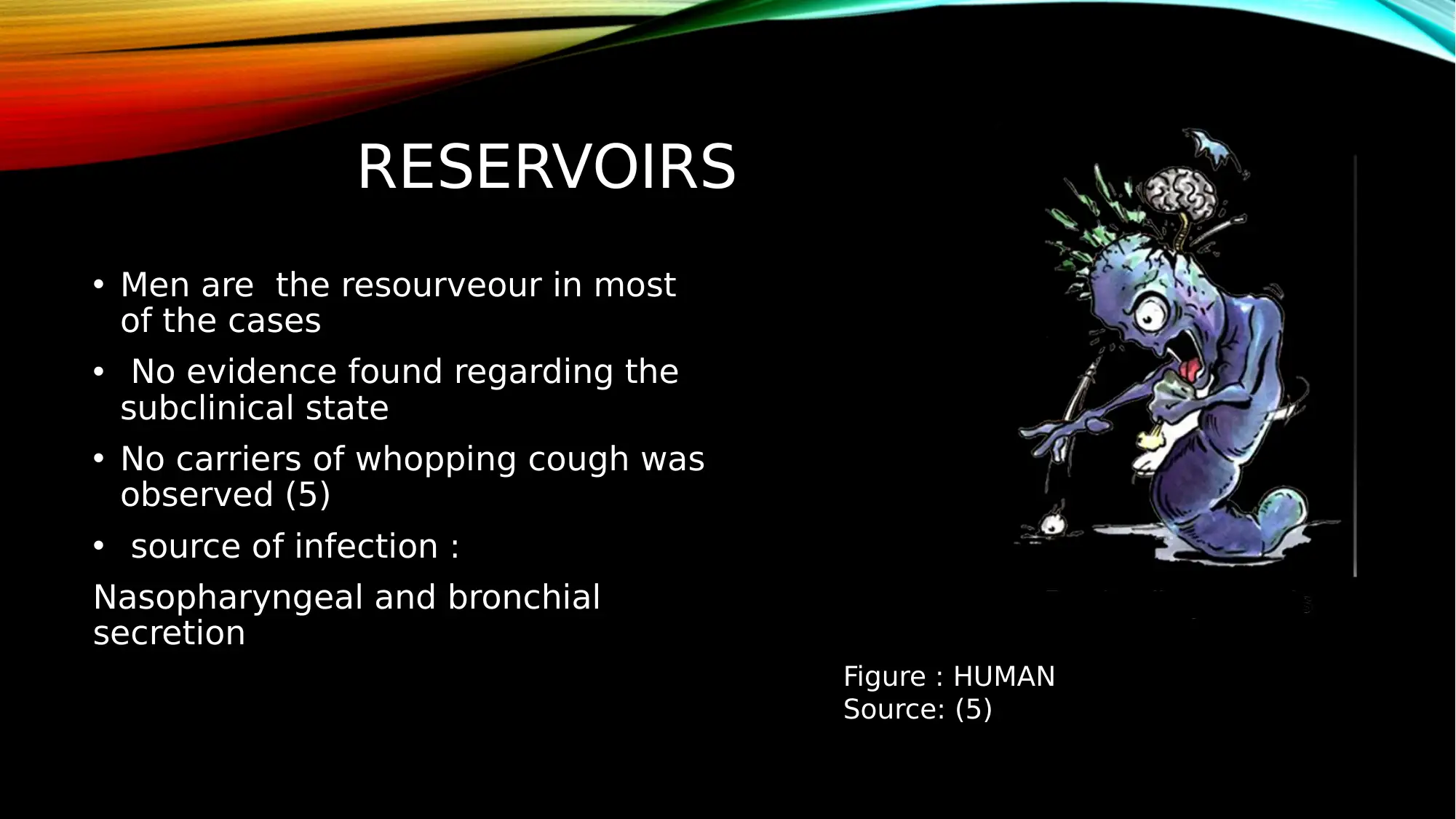
RESERVOIRS
• Men are the resourveour in most
of the cases
• No evidence found regarding the
subclinical state
• No carriers of whopping cough was
observed (5)
• source of infection :
Nasopharyngeal and bronchial
secretion
Figure : HUMAN
Source: (5)
• Men are the resourveour in most
of the cases
• No evidence found regarding the
subclinical state
• No carriers of whopping cough was
observed (5)
• source of infection :
Nasopharyngeal and bronchial
secretion
Figure : HUMAN
Source: (5)
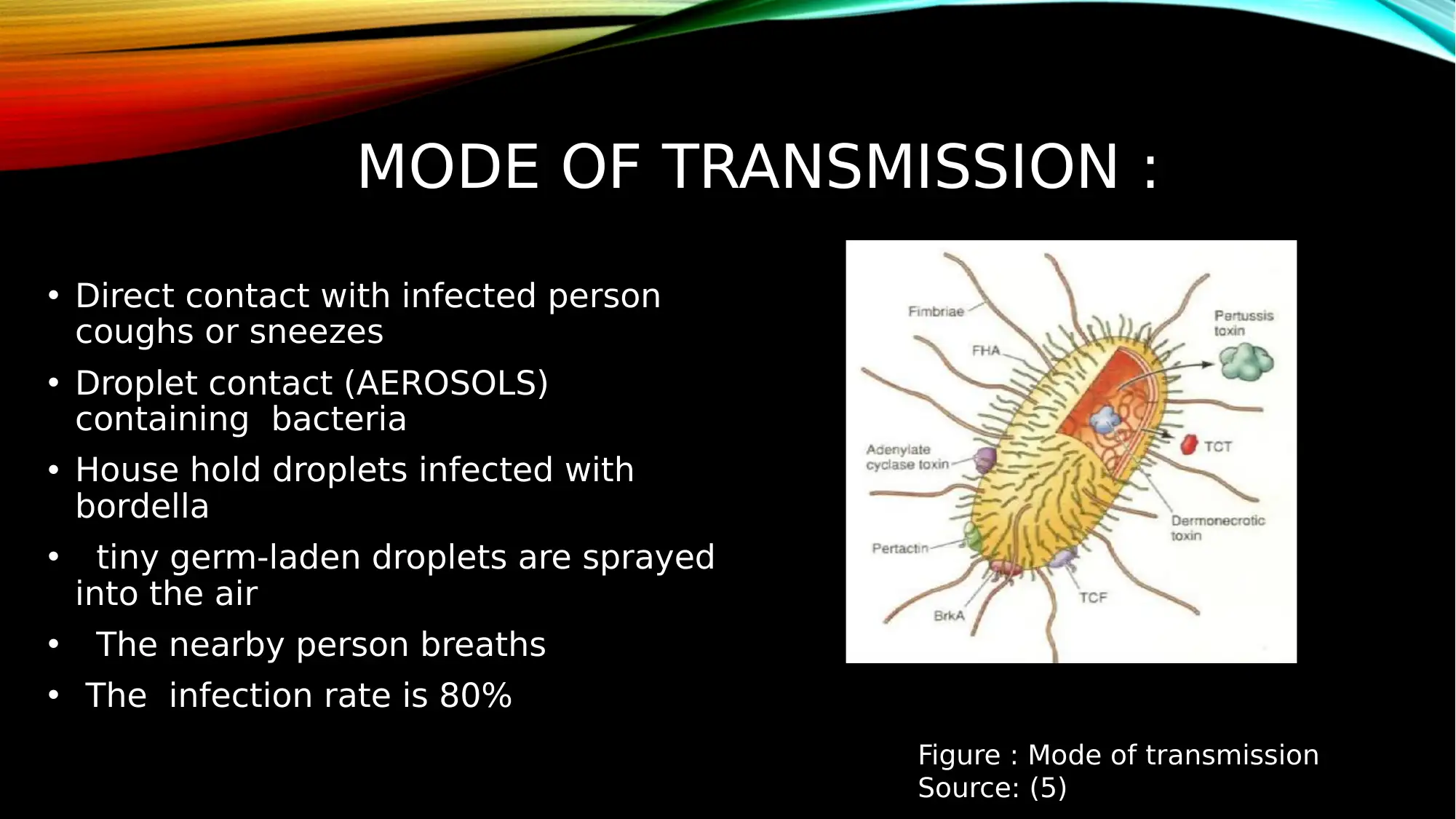
MODE OF TRANSMISSION :
• Direct contact with infected person
coughs or sneezes
• Droplet contact (AEROSOLS)
containing bacteria
• House hold droplets infected with
bordella
• tiny germ-laden droplets are sprayed
into the air
• The nearby person breaths
• The infection rate is 80%
Figure : Mode of transmission
Source: (5)
• Direct contact with infected person
coughs or sneezes
• Droplet contact (AEROSOLS)
containing bacteria
• House hold droplets infected with
bordella
• tiny germ-laden droplets are sprayed
into the air
• The nearby person breaths
• The infection rate is 80%
Figure : Mode of transmission
Source: (5)
⊘ This is a preview!⊘
Do you want full access?
Subscribe today to unlock all pages.

Trusted by 1+ million students worldwide
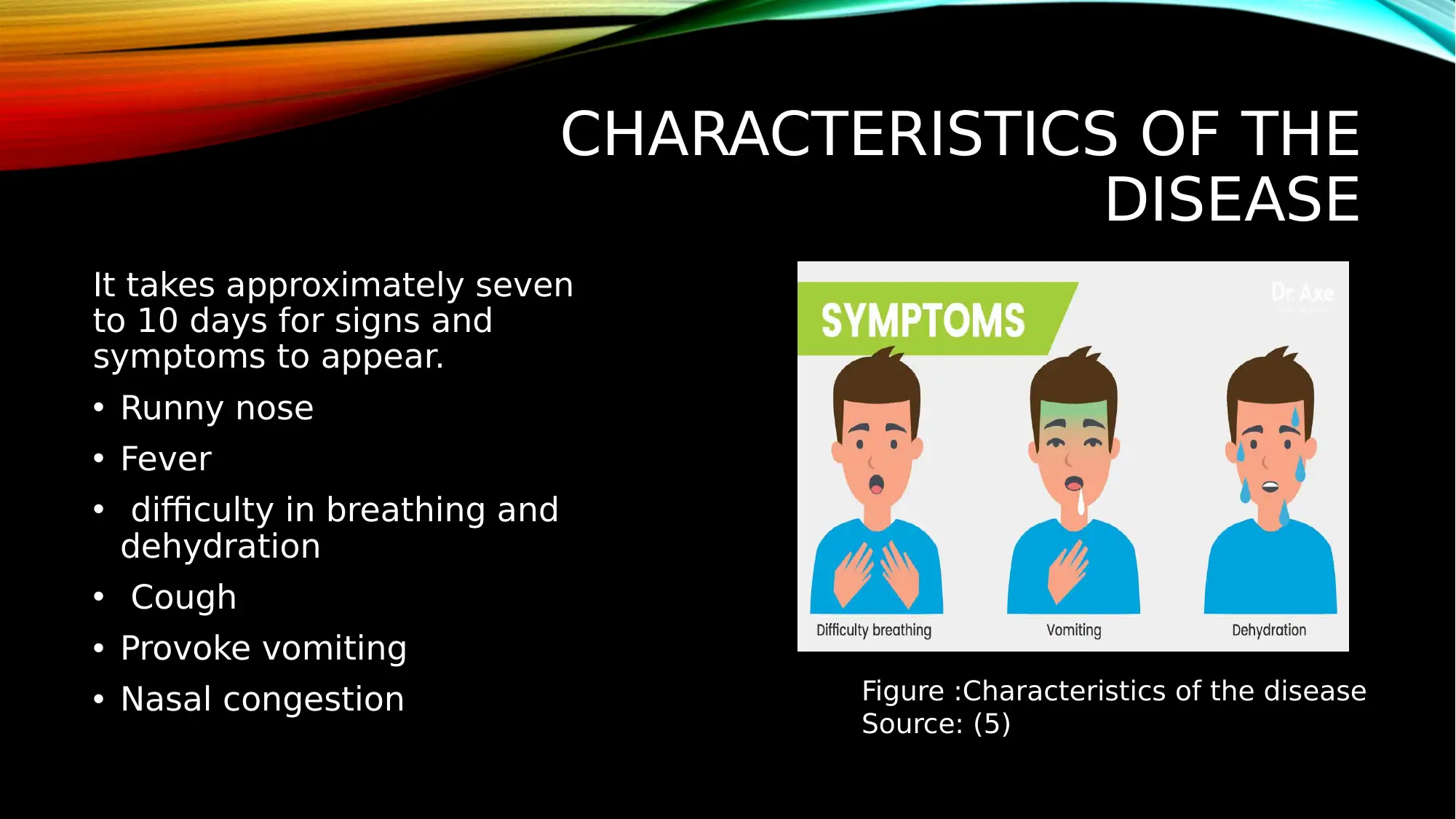
CHARACTERISTICS OF THE
DISEASE
It takes approximately seven
to 10 days for signs and
symptoms to appear.
• Runny nose
• Fever
• difficulty in breathing and
dehydration
• Cough
• Provoke vomiting
• Nasal congestion Figure :Characteristics of the disease
Source: (5)
DISEASE
It takes approximately seven
to 10 days for signs and
symptoms to appear.
• Runny nose
• Fever
• difficulty in breathing and
dehydration
• Cough
• Provoke vomiting
• Nasal congestion Figure :Characteristics of the disease
Source: (5)
Paraphrase This Document
Need a fresh take? Get an instant paraphrase of this document with our AI Paraphraser
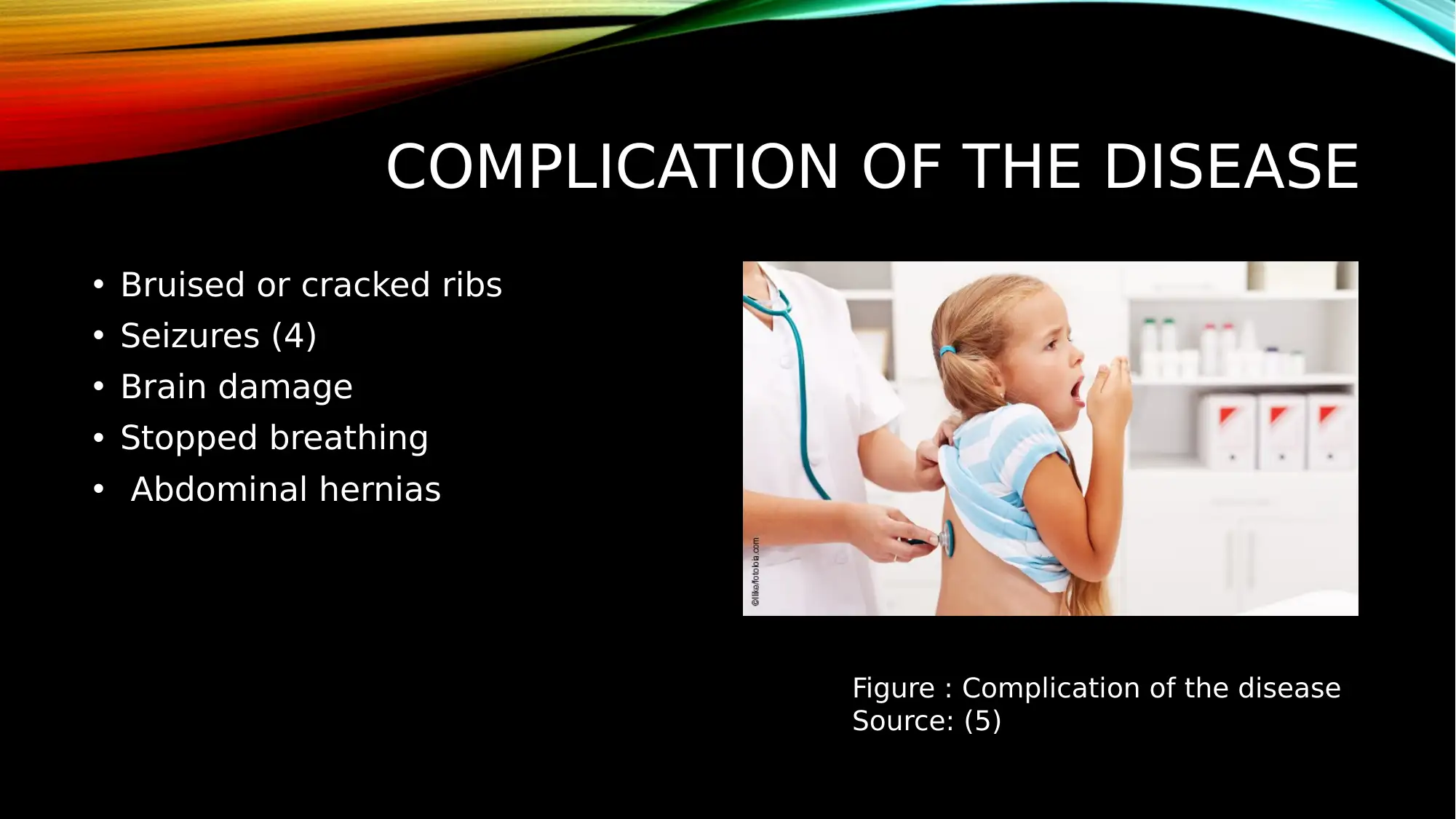
COMPLICATION OF THE DISEASE
• Bruised or cracked ribs
• Seizures (4)
• Brain damage
• Stopped breathing
• Abdominal hernias
Figure : Complication of the disease
Source: (5)
• Bruised or cracked ribs
• Seizures (4)
• Brain damage
• Stopped breathing
• Abdominal hernias
Figure : Complication of the disease
Source: (5)
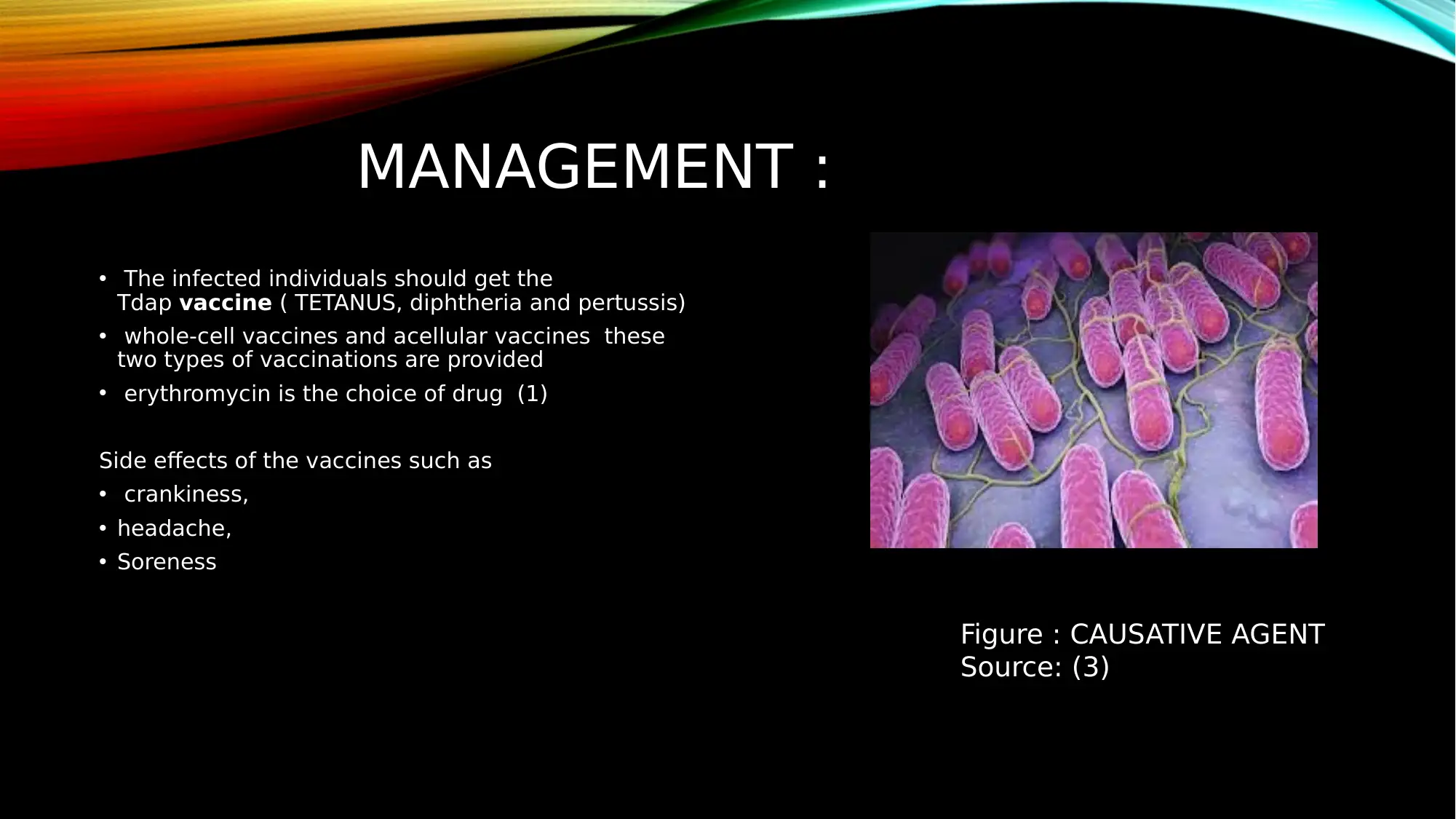
MANAGEMENT :
• The infected individuals should get the
Tdap vaccine ( TETANUS, diphtheria and pertussis)
• whole-cell vaccines and acellular vaccines these
two types of vaccinations are provided
• erythromycin is the choice of drug (1)
Side effects of the vaccines such as
• crankiness,
• headache,
• Soreness
Figure : CAUSATIVE AGENT
Source: (3)
• The infected individuals should get the
Tdap vaccine ( TETANUS, diphtheria and pertussis)
• whole-cell vaccines and acellular vaccines these
two types of vaccinations are provided
• erythromycin is the choice of drug (1)
Side effects of the vaccines such as
• crankiness,
• headache,
• Soreness
Figure : CAUSATIVE AGENT
Source: (3)
⊘ This is a preview!⊘
Do you want full access?
Subscribe today to unlock all pages.

Trusted by 1+ million students worldwide
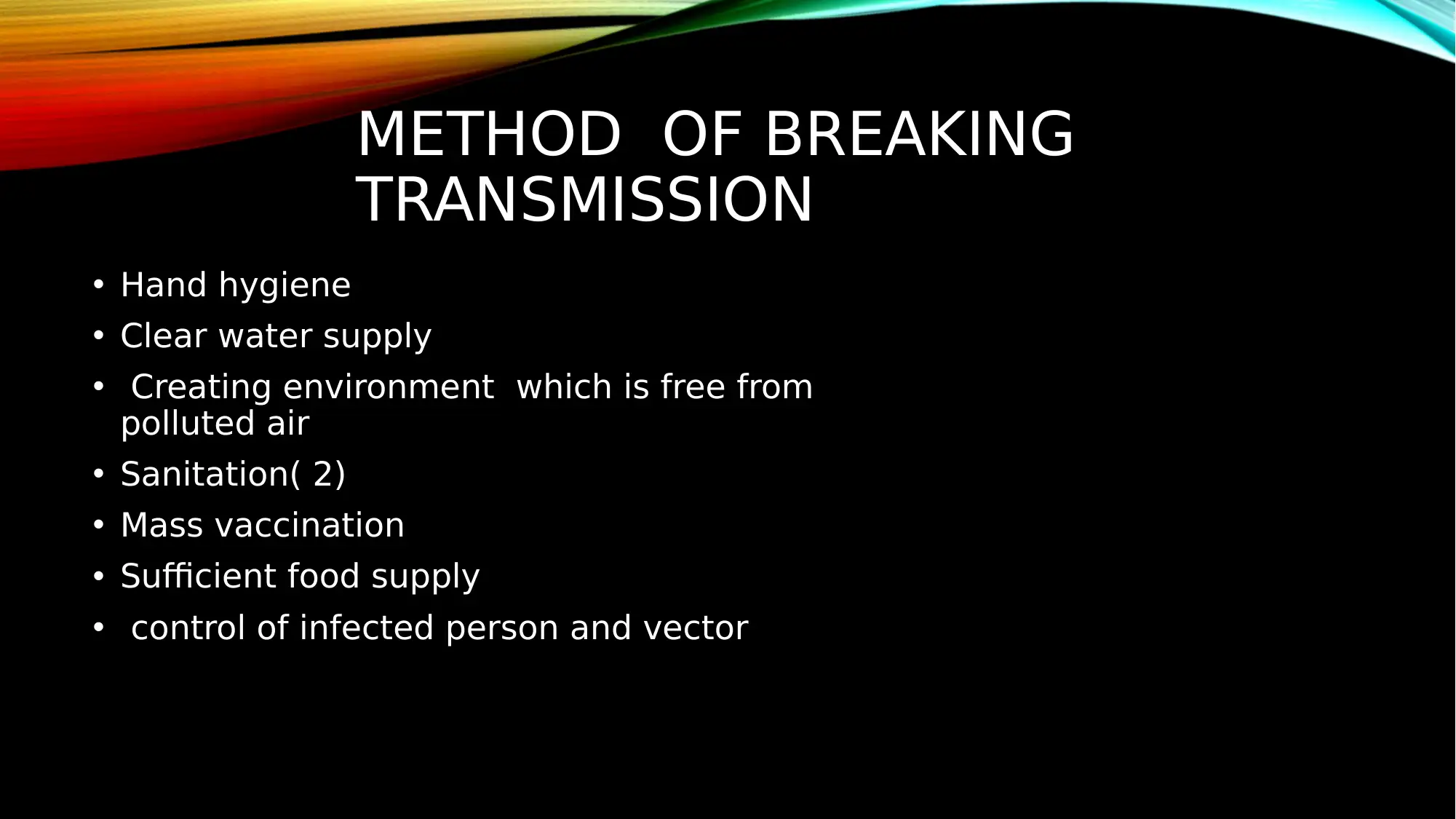
METHOD OF BREAKING
TRANSMISSION
• Hand hygiene
• Clear water supply
• Creating environment which is free from
polluted air
• Sanitation( 2)
• Mass vaccination
• Sufficient food supply
• control of infected person and vector
TRANSMISSION
• Hand hygiene
• Clear water supply
• Creating environment which is free from
polluted air
• Sanitation( 2)
• Mass vaccination
• Sufficient food supply
• control of infected person and vector
Paraphrase This Document
Need a fresh take? Get an instant paraphrase of this document with our AI Paraphraser
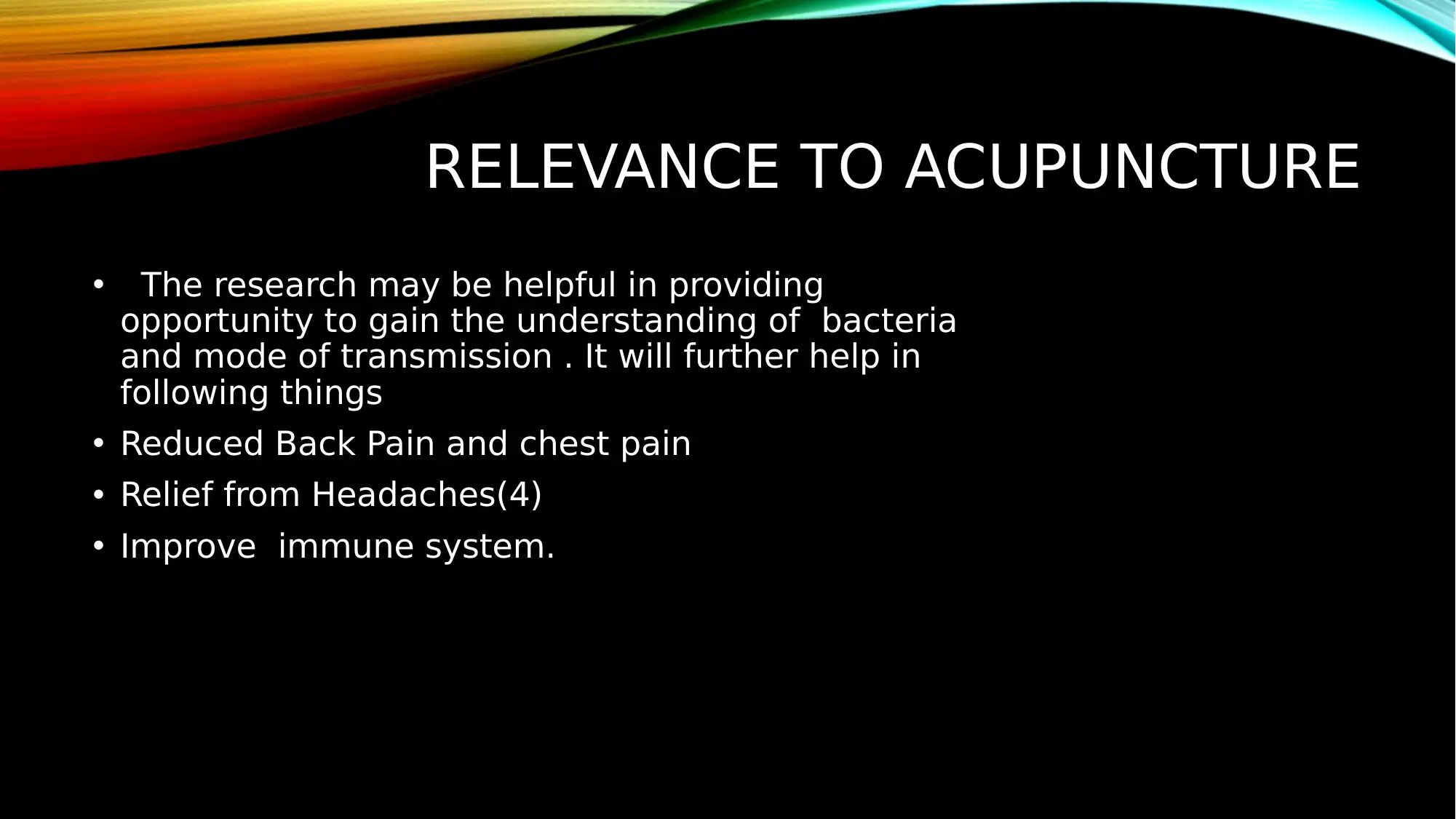
RELEVANCE TO ACUPUNCTURE
• The research may be helpful in providing
opportunity to gain the understanding of bacteria
and mode of transmission . It will further help in
following things
• Reduced Back Pain and chest pain
• Relief from Headaches(4)
• Improve immune system.
• The research may be helpful in providing
opportunity to gain the understanding of bacteria
and mode of transmission . It will further help in
following things
• Reduced Back Pain and chest pain
• Relief from Headaches(4)
• Improve immune system.
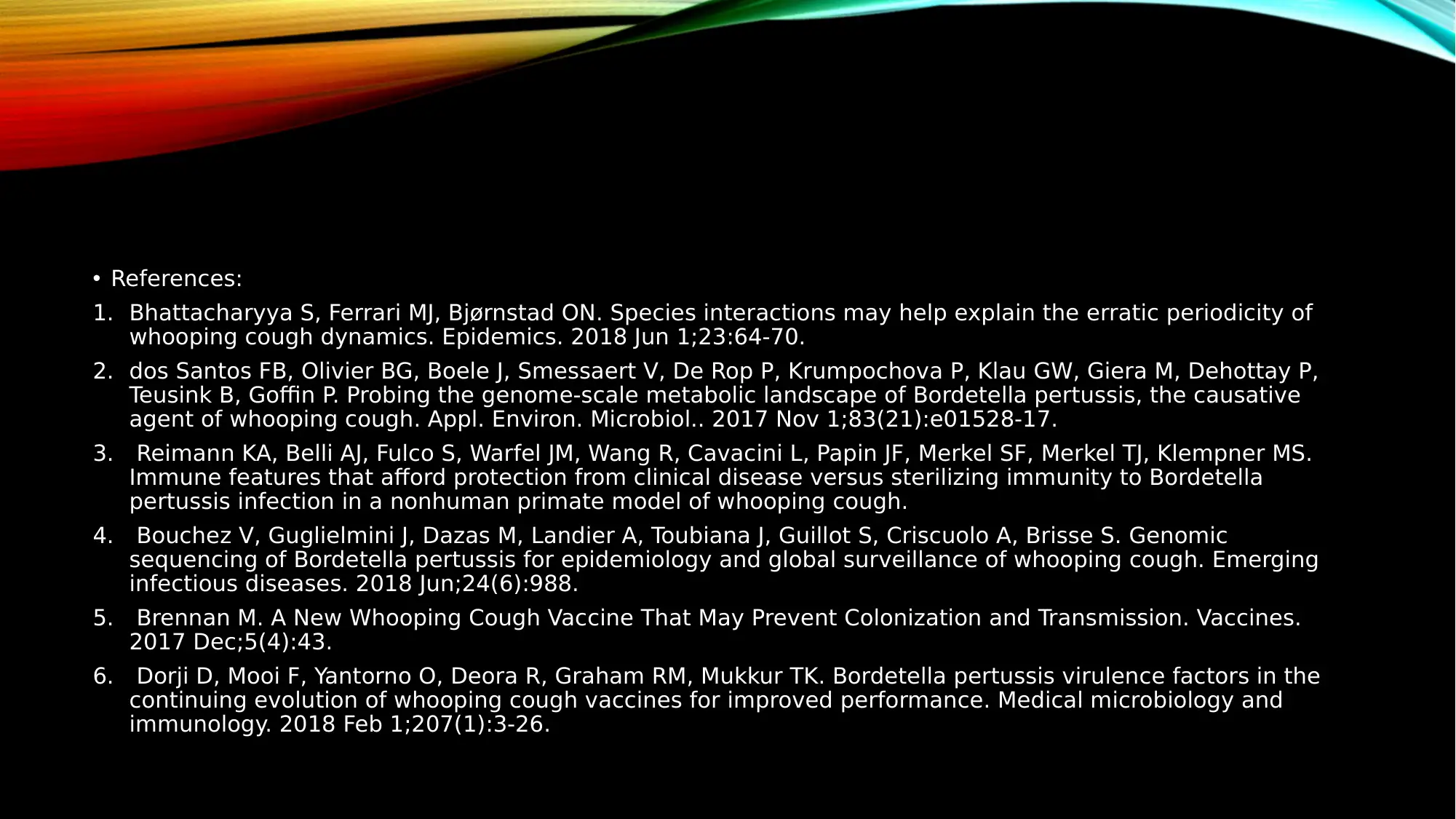
• References:
1. Bhattacharyya S, Ferrari MJ, Bjørnstad ON. Species interactions may help explain the erratic periodicity of
whooping cough dynamics. Epidemics. 2018 Jun 1;23:64-70.
2. dos Santos FB, Olivier BG, Boele J, Smessaert V, De Rop P, Krumpochova P, Klau GW, Giera M, Dehottay P,
Teusink B, Goffin P. Probing the genome-scale metabolic landscape of Bordetella pertussis, the causative
agent of whooping cough. Appl. Environ. Microbiol.. 2017 Nov 1;83(21):e01528-17.
3. Reimann KA, Belli AJ, Fulco S, Warfel JM, Wang R, Cavacini L, Papin JF, Merkel SF, Merkel TJ, Klempner MS.
Immune features that afford protection from clinical disease versus sterilizing immunity to Bordetella
pertussis infection in a nonhuman primate model of whooping cough.
4. Bouchez V, Guglielmini J, Dazas M, Landier A, Toubiana J, Guillot S, Criscuolo A, Brisse S. Genomic
sequencing of Bordetella pertussis for epidemiology and global surveillance of whooping cough. Emerging
infectious diseases. 2018 Jun;24(6):988.
5. Brennan M. A New Whooping Cough Vaccine That May Prevent Colonization and Transmission. Vaccines.
2017 Dec;5(4):43.
6. Dorji D, Mooi F, Yantorno O, Deora R, Graham RM, Mukkur TK. Bordetella pertussis virulence factors in the
continuing evolution of whooping cough vaccines for improved performance. Medical microbiology and
immunology. 2018 Feb 1;207(1):3-26.
1. Bhattacharyya S, Ferrari MJ, Bjørnstad ON. Species interactions may help explain the erratic periodicity of
whooping cough dynamics. Epidemics. 2018 Jun 1;23:64-70.
2. dos Santos FB, Olivier BG, Boele J, Smessaert V, De Rop P, Krumpochova P, Klau GW, Giera M, Dehottay P,
Teusink B, Goffin P. Probing the genome-scale metabolic landscape of Bordetella pertussis, the causative
agent of whooping cough. Appl. Environ. Microbiol.. 2017 Nov 1;83(21):e01528-17.
3. Reimann KA, Belli AJ, Fulco S, Warfel JM, Wang R, Cavacini L, Papin JF, Merkel SF, Merkel TJ, Klempner MS.
Immune features that afford protection from clinical disease versus sterilizing immunity to Bordetella
pertussis infection in a nonhuman primate model of whooping cough.
4. Bouchez V, Guglielmini J, Dazas M, Landier A, Toubiana J, Guillot S, Criscuolo A, Brisse S. Genomic
sequencing of Bordetella pertussis for epidemiology and global surveillance of whooping cough. Emerging
infectious diseases. 2018 Jun;24(6):988.
5. Brennan M. A New Whooping Cough Vaccine That May Prevent Colonization and Transmission. Vaccines.
2017 Dec;5(4):43.
6. Dorji D, Mooi F, Yantorno O, Deora R, Graham RM, Mukkur TK. Bordetella pertussis virulence factors in the
continuing evolution of whooping cough vaccines for improved performance. Medical microbiology and
immunology. 2018 Feb 1;207(1):3-26.
⊘ This is a preview!⊘
Do you want full access?
Subscribe today to unlock all pages.

Trusted by 1+ million students worldwide
1 out of 13
Related Documents
Your All-in-One AI-Powered Toolkit for Academic Success.
+13062052269
info@desklib.com
Available 24*7 on WhatsApp / Email
![[object Object]](/_next/static/media/star-bottom.7253800d.svg)
Unlock your academic potential
Copyright © 2020–2025 A2Z Services. All Rights Reserved. Developed and managed by ZUCOL.





